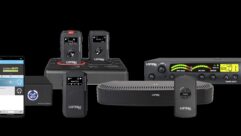New directions in taxes
Dec 1, 1997 12:00 PM,
Milton Zall
New legislation already enacted into law will affect many privatetaxpayers. But how will it affect small-business owners, especially thosein the sound and video industry?
If you are a small-business owner, or even if you work for or deal withsmall businesses, you have probably heard something about the taxpayerrelief act of 1997. Some of the provisions of this law have been widelyreported in the general press; others have not. Consequently, you may nothave received much information on the provisions that are likely to benefitcompanies in this industry. In this article, we will take a close look athow this law will affect your family and how your business will be affectedby this legislation. We will also suggest steps you should take to maximizecurrent benefits.
Benefits for families [RECOMMEND MICHAEL HAVE A DIFFERENT SUBHEAD TREATMENTFOR THIS SUBHEAD AND THE ONES ABOUT EMPLOYEE BENEFITS AND BENEFITS FORSELF-EMPLOYED SOUND CONTRACTORS — PLACES WITH TWO SUBHEADS IN A ROW]
Education tax reliefThe new law provides $31 billion in “HOPE” scholarships. You can claim aHOPE credit against federal income taxes up to $1,000 per student per yearfor 100% of the first $1,000 in tuition and related expenses up to $500 for50% of the next $1,000 paid for the first two years of a student’spost-secondary education in degree or certificate programs. Room and boardand book expenses are excluded. The tuition expenses must be incurred onyour or your spouse’s behalf or on behalf of a dependent child claimed onyour tax return. The HOPE credit is available to an individual student fortwo taxable years provided that the student has not completed the first twoyears of post-secondary education. Beginning in 1998, the maximum creditamount of $1,500 will be indexed for inflation. The HOPE credit amount isphased out for taxpayers with modified adjusted gross income (AGI) between$40,000 and $50,000 ($80,000 and $100,000 for joint returns); therefore,many readers will benefit from this provision.
The law also permits individual taxpayers to claim a nonrefundable”lifetime learning” credit against federal income taxes equal to 20% oftuition and fees incurred during the taxable year on behalf of thetaxpayer, the taxpayer’s spouse or any dependents. For expenses paid afterJune 30, 1998, and before Jan. 1, 2003, up to $5,000 of qualified tuitionand fees per taxpayer return will be eligible for the 20% lifetime learningcredit, which means that the maximum credit per taxpayer return will be$1,000. For expenses paid after Dec. 31, 2002, up to $10,000 of tuition andfees per taxpayer return will be eligible for the 20% lifetime learningcredit (i.e., the maximum credit per taxpayer return will be $2,000). Thelifetime learning credit is phased out over the same range that applies tothe HOPE credit — single taxpayers with modified AGI between $40,000 and$50,000 ($80,000 and $100,000 for joint returns).
Increase in health insurance deductions for education IRAsAnnual non-tax-deductible contributions to education IRAs to help financeyour children’s higher education are permitted, allowing up to $500 perchild. This $500 annual contribution limit for education IRAs is phased outfor contributors with AGI between $95,000 and $110,000 ($150,000 and$160,000 for joint returns).
The income generated by the education IRA is tax free if the money is usedfor higher-education expenses. Although the intention of this legislationis admirable, it is questionable as to whether many financial institutionswill be eager to set up education IRA accounts that initially contain only$500. Many mutual funds require a minimum account balance of $1,000 to$5,000. Banks may be more accommodating, but your money will not grow fastenough to pay junior’s college tuition if you have an education IRA with abank that pays 5% interest. Shop around; it is likely that some mutualfunds will be interested in this new investment vehicle.
Student loan interestStudent loan interest is once again deductible, even for those who do notitemize on their tax return. The maximum deduction is phased in over fouryears with a $1,000 maximum deduction in 1998, $1,500 in 1999, $2,000 in2000, and $2,500 in 2001. The maximum deduction amount is not indexed forinflation.
In addition, the deduction is phased out for individual taxpayers withmodified AGI of $40,000 to $55,000 ($60,000 to $75,000 for joint returns);these income ranges will be indexed for inflation after the year 2002.Thefirst taxable year for which the inflation adjustment can be made will be2003. The interest deduction can be taken by parents or children who borrowto finance higher-education expenses.
IRA withdrawals for educational expensesThe 10% early (prior to age 59 1/2) withdrawal tax does not apply todistributions from IRAs if you use the amounts to pay higher-educationexpenses (including those related to graduate-level courses) for yourself,your spouse or any child or grandchild of yours or your spouse’s. This isnot a recommended approach, but a fallback option is always nice to have.
Exclusion of gain on personal residenceIndividuals are permitted to exclude from taxable income up to $250,000($500,000 for married couples) of gain on the sale of their home. Toqualify, the taxpayer must have owned and used the property as a principalresidence for at least two years during the five years prior to the sale orexchange.
Child tax creditEffective for tax years after 1997, a tax credit of $500 ($400 for the 1998tax year) is available for each qualifying dependent younger than age 17.The credit is available for a taxpayer’s son, daughter, grandchild oreligible foster child. The child credit is phased out for joint filers withgross income exceeding $110,000 ($75,000 for singles and heads ofhouseholds; $55,000 for married people who file separately).
Employee benefits
Educational-assistance exclusionSection 127 of the tax law, before expiring on June 30, 1997, provided a$5,250 annual income exclusion for employer-provided educational assistance(including graduate-level education before June 30, 1996). Theeducational-assistance exclusion is now reinstated retroactively andextended to courses of instruction beginning before May 31, 2000. Theextended exclusion does not however, apply to graduate-level courses.
Expanded individual retirement accountsThe new tax law creates a “back-ended” IRA with penalty-free withdrawalsfor first-time home purchases. The new IRA, called the “Roth IRA,” has amaximum annual contribution limit of $2,000. You get no tax deduction forcontributing to a Roth IRA, but qualified distributions from a Roth IRA arenot included in income for tax purposes. Qualified distributions meet thefollowing criteria:
* They must be made five taxable years after the first taxable year forwhich a contribution was made to a Roth IRA.
* They are either made on or after the date on which you attain age 59 1/2,made to a beneficiary on or after your death, attributable to your beingdisabled, or used for the purchase of a first home.
The maximum contribution that can be made to a Roth IRA is phased out forindividuals with AGI between $95,000 and $110,000 and for joint filers withAGI between $150,000 and $160,000.
No more than $2,000 of annual contributions can be made to all of anindividual’s IRAs. This means that although restrictions on IRA investmentshave been relaxed, you still can not stash away a ton of money into an IRA.If your AGI is less than $100,000, then you are eligible to roll over orconvert an IRA into a Roth IRA. A regular IRA may be converted to a RothIRA before Jan. 1, 1999. Amounts that would have been included in incomehad the converted amounts been withdrawn from your IRA are still includedin income, but you can spread out the tax liability over four years. Theadditional tax on early withdrawals does not apply to conversions of IRAsto Roth IRAs. The pros and cons for such a switch vary considerably,depending upon your financial situation, age and other factors. This is adecision best left to discussion with your financial advisor or tax planner.
The new law also gradually raises income thresholds for married couples fordeductible IRAs to $80,000 (up from the current level of $40,000) and forsingle taxpayers to $50,000. This provision allows more working spouses tohave a deductible IRA.
Under prior law, if you or your spouse were an active participant in anemployer-sponsored retirement plan (such as a 401k), then the $2,000 IRAdeduction limit would be phased out over the following levels of AGI:$25,000 to $35,000 in the case of a single taxpayer and $40,000 to $50,000in the case of married taxpayers. Under the new legislation, you are notconsidered an active participant in an employer-sponsored retirement planmerely because your spouse is an active participant.
Deductible IRA income phase-out limits are increased as shown in Table 1.
Table 1.Income phase-out limits
Taxable years beginning in: Phase-out range Married taxpayers [???? checkwith author]
1998 $50,000 to 60,0001999 $51,000 to $61,0002000 $52,000 to $62,0002001 $53,000 to $63,0002002 $54,000 to $64,0002003 $60,000 to $70,0002004 $65,000 to $75,0002005 $70,000 to $80,0002006 $75,000 to $85,0002007 and thereafter $80,000 to 100,000
Single taxpayers
1998 $30,000 to $40,0001999 $31,000 to $41,0002000 $32,000 to $42,0002001 $33,000 to $43,0002002 $34,000 to $44,0002003 $40,000 to $50,0002004 $45,000 to $55,0002005 and thereafter $50,000 to $60,000
Benefits for self-employed sound contractors
Estate tax relief for small-business ownersThe new legislation provides an almost immediate increase in the estate taxthreshold from $600,000 to $1.3 million ($2.6 million for couples) forsmall, family-owned businesses, effective Jan. 1, 1998. An estate whosevalue falls below the threshold owes no federal estate tax.
For purposes of the provision, a family-owned business is defined as anytrade or business (regardless of the form in which it is held) with aprincipal place of business in the United States and ownership of the tradeor business held at least 50% by one family, 70% by two families or 90% bythree families, as long as the decedent’s family owns at least 30% of thetrade or business. A decedent’s estate qualifies for the special treatmentonly if the total value of the decedent’s family-owned business intereststhat are passed to his heirs exceeds 50% of the value of the decedent’sestate or adjusted gross estate. This provision is called the 50% liquiditytest.
There are some additional requirements that must be met. If the 50%liquidity test is met but the business’s stock was publicly traded duringthe three-year period preceding the death of the owner, the estate is noteligible for special treatment. In addition, an estate will not qualify forspecial treatment if more than 35% of the adjusted gross income of thebusiness during the year of death came from personal holding companyincome. This provision applies only to individuals who were U.S. citizensor residents when they died.
As you can see, properly calculating the value of an estate to determinewhether it meets the 50% liquidity test is extremely important and shouldbe performed by an expert in estate taxes. The bottom line is that not allfamily-owned businesses will qualify for this new provision, but consultingan estate planning specialist now makes a lot of sense, particularly ifyour non-business assets are substantial. Rest assured that various schemeswill be devised to help you qualify for the 50% liquidity test.
Another requirement associated with this change is that your heirs do notdispose of the business for at least 10 years. If they do not meet thisrequirement, they lose the tax break. If it is likely that your heirs willowe estate taxes, notwithstanding this change in the law, because the valueof your estate will exceed the exempt amount, then it is a priority toconsult an estate tax specialist for advice on how to ensure that yourheirs can pay their estate tax liability without being forced to sell yourbusiness.
Installment payment of estate taxAn executor may elect to pay the federal estate tax attributable to aninterest in a closely held pharmacy in installments over a 14-year period.The tax on the first $1 million in value of a closely held business iseligible for a special 4% interest rate. The new law changes the interestrate to 2%, and the eligible amount is now indexed for inflation. Inaddition, the interest rate for deferred estate tax on the taxable value ofthe closely held business over $1 million is reduced to 45% of theprevailing rate on tax underpayments. Previously, the rate was equal to thefull rate on tax underpayments.
If your estate does not qualify under these small-business provisions, allis not lost. The new law also provides an increase in the estate taxexemption for those who do not own a family business, to $1 million, andthis is phased in over a nine-year period according to the followingschedule: $625,000 in 1998; $650,000 in 1999; $675,000 in 2000 and 2001;$700,000 in 2002 and 2003; $850,000 in 2004; $950,000 in 2005, and $1million in 2006 and thereafter. This increase is not indexed for inflation,which means that over time, these amounts will decline in real buying powerterms as a result of inflation. The $10,000 annual gift-giving exclusion,however, is now indexed for inflation but, wouldn’t you know it, only inincrements of $1,000. Therefore, it will be a few years before this amountis changed.
Estimated tax paymentsEffective for tax years after 1997, the new law raises from $500 to $1,000the threshold of total tax liability for underpaying estimated tax.
Capital gains tax reliefA top tax rate of 20% now applies to business assets held at least 18months prior to being sold by those in the 28% or higher tax bracket. A 10%top rate will apply to those who are in the 15% income tax bracket. Assetsheld at least 12 months but less than 18 months that are sold after July28, 1997, will be taxed at a maximum rate of 28%, the same as under theprevious law. The law provides a reduction in the capital gains tax butrequires you to hold on to assets for a longer period of time beforeselling them in order to qualify for the reduced rate.
More capital gains reliefA new 18% top capital gains rate will apply to those who are in the 28% orhigher tax bracket and who sell assets held for five years or longer thatare acquired in 2001 or later. A new 8% rate will apply at that time tothose in the 15% tax bracket.
The effective date for the 10% and 20% capital gains rate changes is May 5,1997. The lower capital gains rates are not considered to be a taxpreference, subject to the alternative minimum tax.
Rollover of gain on small business stockGain from the sale of qualified small business stock held more than sixmonths can be deferred if the proceeds from the sale are used to purchaseother qualified small business stock within 60 days of the sale. Gain onthe transaction can eventually qualify for the 50% capital gain exclusionfor small business stock when the replacement stock is sold. This newrollover rule applies to sales after Aug. 5, 1997.
Increase in health insurance deductions for self-employed sound contractorsSelf-employed sound contractors will eventually be able to deduct 100% oftheir health insurance costs. The current deduction of 40% had beenscheduled to increase to 80% over a period of years. Now, the deductionwill be 40% for 1997, 45% for 1998-1999, 50% for 2000- 2001, 60% for 2002,80% for 2003-2005, 90% for 2006, and 100% thereafter.
More favorable rules for home office deductionThe new law expands upon an earlier Supreme Court decision restricting thehome office deduction to those whose home was their “principal place ofbusiness.” A home office now qualifies as your principal place of businessif you use the office to conduct administrative or management activities ofa trade or business and you do not have another fixed location of the tradeor business where you conduct substantial administrative or managementactivities of the trade or business. As under present law, deductions willbe allowed for a home office meeting the above two-part test only if youuse the office exclusively and on a regular basis as a place of business.
Alternative minimum tax for small business corporationsFor tax years beginning in 1998, certain small business corporations areeffectively exempt from the corporate AMT. To qualify, a small businessmust have average gross receipts of $5 million or less for the three yearsprior to its 1998 tax year. Either to continue to qualify after 1998 or toqualify as a small business for the first time, a company’s three-yearaverage gross receipts cannot exceed $7.5 million. Small businesscorporations qualifying for the exemption will not be subject to any of themultiple calculations or record-keeping requirements of the AMT system.
There you have it. The major provisions of the new tax law that are ofinterest to sound contractors and their families. Although the new lawcontains other provisions that may interest individual readers, we believethe major ones are described in this article. To play it safe, however, youshould consult your accountant or tax advisor.










